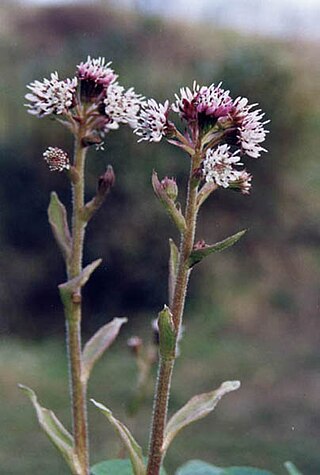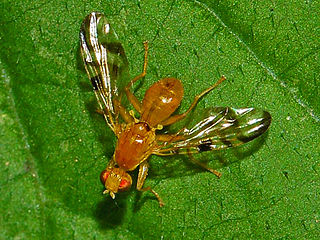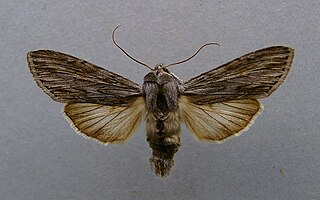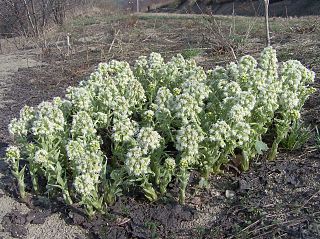
Petasites is a genus of flowering plants in the sunflower family, Asteraceae, that are commonly referred to as butterburs and coltsfoots. They are perennial plants with thick, creeping underground rhizomes and large rhubarb-like leaves during the growing season. Most species are native to Asia or southern Europe.

Tussilago farfara, commonly known as coltsfoot, is a plant in the tribe Senecioneae in the family Asteraceae, native to Europe and parts of western and central Asia. The name "tussilago" is derived from the Latin tussis, meaning cough, and ago, meaning to cast or to act on. It has had uses in traditional medicine, but the discovery of toxic pyrrolizidine alkaloids in the plant has resulted in liver health concerns.

Petasites frigidus, the Arctic sweet coltsfoot or Arctic butterbur, is a species of flowering plant in the family Asteraceae. It is native to Arctic to cool temperate regions of the Northern Hemisphere in northern Europe, northern Asia and northern North America.

Petasites hybridus, also known as the butterbur, is a herbaceous perennial flowering plant in the family Asteraceae that is native to Europe and northern Asia.

Petasites japonicus, also known as butterbur, giant butterbur, great butterbur and sweet-coltsfoot, is an herbaceous perennial plant in the family Asteraceae. It is native to China, Japan, Korea and Sakhalin and introduced in Europe and North America. It was introduced to southern British Columbia in Canada by Japanese migrants.

Petasites pyrenaicus, the winter heliotrope, is a medicinal and ornamental flowering plant in the family Asteraceae.

Typhula incarnata is a fungal plant pathogen in the family Typhulaceae.
Butterbur is the common name of several plants in the genus Petasites.

Platyptilia gonodactyla, also known as the triangle plume, is a moth of the family Pterophoridae found in temperate Asia and Europe. It was first described by the Austrian entomologists, Michael Denis & Ignaz Schiffermüller in 1775.
Coltsfoot is the common name for several plants in the family Asteraceae:

Acidia cognata is a species of fly in the family Tephritidae.

Cucullia lucifuga is a species of moth of the family Noctuidae. It is found in north, central and southern Europe east to Japan. It is also present in Tibet and Armenia.

Petasites albus, the white butterbur, is a flowering plant species in the family Asteraceae. It is native to central Europe and the Caucasus.

Typhula is a genus of clavarioid fungi in the order Agaricales. Species of Typhula are saprotrophic, mostly decomposing leaves, twigs, and herbaceous material. Basidiocarps are club-shaped or narrowly cylindrical and are simple, often arising from sclerotia. A few species are facultative plant pathogens, causing a number of commercially important crop and turfgrass diseases.

Typhula quisquiliaris, commonly known as the bracken club, is a species of club fungus in the family Typhulaceae. It produces small, white fruit bodies up to 9 millimetres (0.4 in) in height, each with a single distinct "head" and "stem". The head is fertile, while the stem attaches to a sclerotium embedded in the substrate. The fruit bodies grow from dead wood, and strongly favours bracken, where the species feeds saprotrophically. Though T. quisquiliaris was described under a different name by James Sowerby in 1803, the specific name quisquiliaris was sanctioned in 1821 by Elias Magnus Fries, and the species was moved to the genus Typhula, which resulted in its currently accepted binomial name by Paul Christoph Hennings in 1896. The species has been recorded in Europe and north Africa.
Typhula blight is most commonly known as a turf disease, but can also be a problem with wheat. Typhula blight is caused by a Typhula fungus, either Typhula incarnata or T. ishikariensis. Typhula incarnata is the causal agent for gray snow mold and T. ishikariensis causes speckled snow mold. Snow molds are caused by cold tolerant fungi that require snow cover or prolonged periods of cold, wet conditions. Typhula blight is most notably found in the turf industry, affecting a wide range of turfgrasses. Upon the snow melt, gray circular patches of mycelium are found. These mycelia produce a survival structure called a sclerotia that survives the warm summer months. Typhula blight is commonly controlled with fungicide applications in the late fall and by other cultural practices. If unchecked, snow molds can cause severe turf loss.
Snow mold is a type of fungus and a turf disease that damages or kills grass after snow melts, typically in late winter. Its damage is usually concentrated in circles three to twelve inches in diameter, although yards may have many of these circles, sometimes to the point at which it becomes hard to differentiate between different circles. Snow mold comes in two varieties: pink or gray. While it can affect all types of grasses, Kentucky bluegrass and fescue lawns are least affected by snow mold.
Erigeron uncialis is a North American species of flowering plant in the family Asteraceae known by the common name lone fleabane or limestone daisy. It is native to the western United States, in the states of Nevada and California.

Cladonia uncialis is a species of fruticose, cup lichen in the family Cladoniaceae. It was first described as a new species by Swedish taxonomist Carl Linnaeus in 1753. It was transferred to the genus Cladonia by Friedrich Heinrich Wiggers in 1780. In North America, the lichen is colloquially known as the thorn Cladonia or the thorn cup lichen.

Typhula erythropus is a species of fungus in the family Typhulaceae, first described by Christiaan Hendrik Persoon and given its current name by Elias Magnus Fries.













